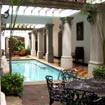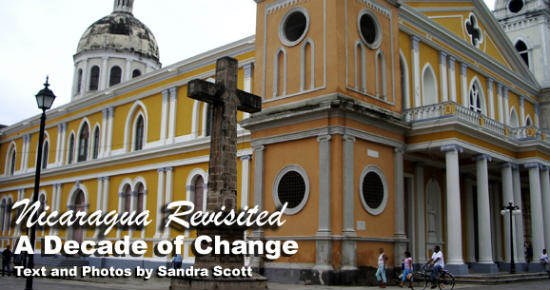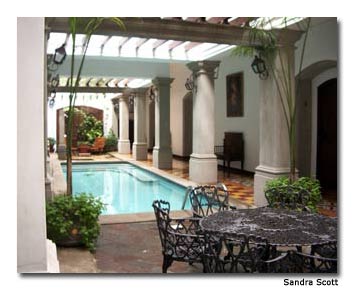

A decade ago, as my husband and I sat in our hotel room overlooking the small Nicaraguan harbor town of San Juan del Sur, about two hours west of the capital of Managua, we agreed there was no need to ever return. The hotel, the best in town at that time, had all the ambiance of the Bates Motel ofPsycho fame.
Other than brilliant sunsets, the small town had little to offer. The crescent beach was littered with debris, a rusting hulk of a ship lazed, lopsided, on the beach with a sign affixed: “Do not urinate on the beach.” That alone was enough to strengthen our resolve to check San Juan del Sur off our “we-have-to-return-someday” list.
But resolutions are made to be broken. A decade later, the view from 4-star Pelican Eyes Hotel, a boutique hotel with a unique, free-form style nestled amid jungle vegetation above the town, showed a different San Juan. The harbor was dotted with small yachts, fishing boats and sailboats. High on the hill, expensive private homes afford their owners a sweeping view of the ocean. The town is abuzz with building and energy.
While eating a gourmet dinner, al fresco, by the hotel’s infinity pool, we marveled at what a difference a decade makes. Two weeks of driving around Nicaragua made us we realize not only can one go back, oneshould go back.
All travel in Nicaragua starts in Managua, situated 28 miles (45 k) inland from the Pacific Ocean, on the shores of Lake Managua. After being leveled by the earthquake of 1972, followed by 30 years of moldering in the tropical sun, the city center of Managua is rising like the Phoenix.
A decade ago the city center was a series of grassy blocks where buildings once stood, except for the InterContinental Hotel, a white, pyramid-shaped building, which survived the earthquake unscathed. Easily seen from everywhere in the city center, it had been our landmark and one of the few upscale accommodations in Managua.
On the way into the city center this time, I said to my husband, John, who was driving, “Don’t worry, I know exactly where we are going. We just need to spot the InterContinental.” But where was it? We drove by the hotel twice, without realizing it. Then we spotted it.
The InterContinental is now the Crowne Plaza. It still retains its classic pyramid shape, but it has been completely remodeled — and it is partly hidden by a hotel convention center and a casino. A new InterContinental is only a 10-minute drive away, as is a Holiday Inn Express. Between the three hotels there are malls, more hotels and fountains.
In the city center, only the stark remains of the old Managua Cathedral, destroyed during the ’72 quake, the Rubin Dario Theatre and a few other buildings stand as reminders of the past.
For me the most intriguing site in Managua is the Huellas de Acahualinca Museum. Here, preserved forever, are 10,000-year-old footprints of men, women, children and animals desperately fleeing a deadly rain of volcanic ash. As I stared at the footprints I could feel a glimmer of their terror, and wondered, “Did they survive?”
Nicaragua is a country of lakes, volcanoes and beaches. From Managua, we headed toward the colonial town of Granada — 27 miles (45 k) north of Managua, on the north shore of Lake Nicaragua — making a detour to Laguna de Apoyo, a volcanic-crater lake.
From the steep side of the crater wall we looked down at the large, dark lake ringed by tropical vegetation. The lake was calm and inviting, but the steep walk down the steps was not.
Thinking about the mountain-goat climb from the lake back up to our room, I advised John, “It’s one trip a day for me! Let’s have lunch at the lakeside restaurant and take our swimsuits with us, so we won’t have to climb back up until after a swim.”
The day was hot, but the water was refreshing. I lounged on the deck, basking in the sun, while my husband sailed a catamaran. It was an afternoon of total relaxation — until we had to climb back up.
Colonial Granada, founded in 1524 by conquistador Francisco Hernández de Córdoba on the shore of Lake Nicaragua, Central America’s largest lake, is getting a facelift. The town’s central plaza still has the ambiance of colonial times, as horse-drawn carriages go clip clopping along. Pastel buildings contrast with the deep blue sky.
We stayed just off the main square in the 19th century La Gran Francía, once a private home, now a beautiful boutique hotel. I felt immediately at home. It was an oasis of relaxation and tranquility. The rooms surrounding the small pool have a feeling of privacy, yet it is but steps from the central plaza.
In the afternoon, John and I drove to a nearby park, where we boarded a boat for a two-hour scenic boat ride to Las Isletas islands, a beautiful volcanic archipelago. Some of the more than 300 islands are inhabited, but most are covered with vegetation, making it a rich habitat for birds.
The largest of the islands, Ometepe, has two volcanoes, Madera and Concepci ón — which rises 5,250 feet (1,600 m) above the island. Clouds frequently shroud the volcanoes, but for a lucky few minutes the cloud halo dissipated, and we were treated to the sight of two perfect cones.
Lake Nicaragua is home to the world’s only freshwater sharks. “Not to worry,” said our boatman, “they are so rare that only a few lucky people ever get to see one.”
We nearly decided to skip the old capital, León, two hours north of Managua, but are glad we did not. The people of this city are beginning to realize that their colonial heritage is a tourist draw, and are painting buildings and offering horse-and-carriage rides. It is a city of churches and museums, including the Metropolitan Cathedral, where Rubén Darío, Nicaragua’s famed poet, who lived from 1867 to 1916, is buried.
The best place to stay here, El Convento Hotel, a new hotel with an old look, is adjacent to the San Francisco Church. We entered to find a large central garden with towering royal palms, halls with colonial artifacts and spacious guestrooms with the simplicity of a convent and all the conveniences of today. Across the street is Centro de Arte Fundación Ortiz Gurdián, Nicaragua’s premier art museum.
Parts of the museum are open to the sky, and I noticed mold on the walls. “The weather is so hot and humid, won’t it destroy the paintings?” I asked an attendant. He explained that it was a problem, but fans and other devices help keep the humidity down. I had my doubts.
One of our favorite places when we visited Nicaragua 10 years ago was Selva Negra (Black Forest) Mountain Resort and Coffee Estate, in the mountains near Matagalpa, about two hours north of Managua. It was one place that seemed unchanged. The owners, Eddy and Mausi Kühl, have their own little kingdom. The gate man raised the “control gate,” and we entered.
Scattered throughout the lush green forest at the foot of cloud-capped mountains are quaint, half-timbered cabins. It is a place to relax, to hike through the forest and even to get married.
The Kühls built a stone church so their four daughters could get married at Selva Negra. The church, its moss-covered roof sprouting orchids, would look at home in Bavaria; it is the perfect setting for a fairy-tale wedding.
Mausi loves to give tours of the coffee plantation, taking great pride in all they have created in the past 25 years. “We have a school for the [plantation workers’] children, a store, and everything we need is organically produced.

Now we are raising flowers. We have our own chickens and cows, so we make our own cheese and sausage. We use the refuse from the coffee beans to make gas to cook with. We use everything.”
My favorite time at Selva Negra is in the early morning, sitting in the open-air restaurant overlooking the pond. The clouds halo the mountains, the red flowers are fresh with dew, the ducks slide across the mirror-calm water, and squawking geese parade as if on guard duty. Slowly the sun burns through the clouds, and the mountains and flowers are reflected in the pond. It is always hard for us to leave Selva Negra.
Our last stop in Nicaragua is always the Barceló Playa Montelimar resort, once the ranch of deposed dictator Somoza, about 90 minutes west of Managua. The all-inclusive resort on one of the most beautiful Pacific beaches was an anomaly 10 years ago, but it will soon have competition, as other hotel chains are building or considering building on the coast.
The resort offers Caribbean-style resort living at low Nicaraguan prices. The biggest change in the past 10 years is that the property has doubled in size. We alternated between swimming in the pool and walking on the beach, with a break for resort activities such as dance lessons. In the evenings we watched the sun set over the Pacific, then enjoyed Vegas-style stage shows.
Nicaragua is on its way to being “the new Costa Rica” — it is perfect for a wedding, a honeymoon or an adventurous vacation featuring smoking volcanoes, pristine beaches, colonial villages, rain forests, artisan markets and friendly people. As the tourist brochure proclaims, Nicaragua is “a land where the sun greets you every morning.”
Driving to the airport in Managua, John and I talked about how safe we felt here; we agreed with Chris Buyer, the owner of Pelican Eyes, that Nicaragua is now one of the safest Latin American countries. John pondered, “Imagine, 10 years ago Nicaragua was considered a risky place to visit. I wonder what changes will occur in the next 10 years?”
If You Go
Nicaraguan Tourism Institute
www.visitanicaragua.com
Pelican Eyes Hotel & Resort
www.piedrasyolas.com
Crowne Plaza Hotels
www.crowneplaza.com
La Gran Francía Hotel y Restaurante
Hotel El Convento
www.hotelelconvento.com.ni
Selva Negra Mountain Resort and Coffee Estate
Barceló Playa Montelimar Hotel
- How to Get Around in Sydney: A Local’s Guide to Traveling Around Sydney - April 24, 2024
- The Low-Key Magic of Ghent, Belgium - April 22, 2024
- Discover the Hidden Charm of Extremadura in Spain - April 20, 2024
